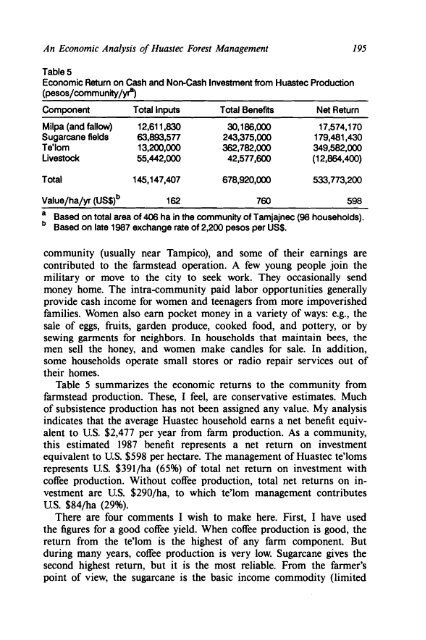Fragile Lands of Latin America Strategies for ... - PART - USAID
Fragile Lands of Latin America Strategies for ... - PART - USAID
Fragile Lands of Latin America Strategies for ... - PART - USAID
You also want an ePaper? Increase the reach of your titles
YUMPU automatically turns print PDFs into web optimized ePapers that Google loves.
An Economic Analysis <strong>of</strong> Huastec Forest Management 195<br />
Table 5<br />
Economic Return on Cash and Non-Cash Investment from Huastec Production<br />
(pesos/community/#)<br />
- - ---<br />
Component Total Inputs Total Benefrts Net Return<br />
Milpa (and fallow) 12,611,830 30,186,000 17,574,170<br />
Sugarcane fields 63,893,577 243,375,000 179,481,430<br />
Te'lom 13,200,000 362,782,000 349,582,000<br />
Livestock 55,442,000 42,577,600 (1 2,864,400)<br />
Total 145,147,407 678,920,000 533,773,200<br />
- - - - - -- - -<br />
a Based on total area <strong>of</strong> 406 ha in the community <strong>of</strong> Tamjajnec (98 households).<br />
Based on late 1987 exchange rate <strong>of</strong> 2,200 pesos per US$.<br />
community (usually near Tampico), and some <strong>of</strong> their earnings are<br />
contributed to the farmstead operation. A few young people join the<br />
military or move to the city to seek work. They occasionally send<br />
money home. The intra-community paid labor opportunities generally<br />
provide cash income fix women and teenagers from more impoverished<br />
families. Women also earn pocket money in a variety <strong>of</strong> ways: e.g., the<br />
sale <strong>of</strong> eggs, fruits, garden produce, cooked food, and pottery, or by<br />
sewing garments <strong>for</strong> neighbors. In households that maintain bees, the<br />
men sell the honey, and women make candles <strong>for</strong> sale. In addition,<br />
some households operate small stores or radio repair services out <strong>of</strong><br />
their homes.<br />
Table 5 summarizes the economic returns to the community from<br />
farmstead production. These, I feel, are conservative estimates. Much<br />
<strong>of</strong> subsistence production has not been assigned any value. My analysis<br />
indicates that the average Huastec household earns a net benefit equiv-<br />
alent to U.S. $2,477 per year from farm production. As a community,<br />
this estimated 1987 benefit represents a net return on investment<br />
equivalent to U.S. $598 per hectare. The management <strong>of</strong> Huastec te'loms<br />
represents U.S. $391/ha (65%) <strong>of</strong> total net return on investment with<br />
c<strong>of</strong>fee production. Without c<strong>of</strong>fee production, total net returns on in-<br />
vestment are U.S. $290/ha, to which te'lom management contributes<br />
US. $84/ha (29%).<br />
There are four comments I wish to make here. First, I have used<br />
the figures <strong>for</strong> a good c<strong>of</strong>fee yield. When c<strong>of</strong>fee production is good, the<br />
return from the te'lom is the highest <strong>of</strong> any farm component. But<br />
during many years, c<strong>of</strong>fee production is very low. Sugarcane gives the<br />
second highest return, but it is the most reliable. From the farmer's<br />
point <strong>of</strong> view, the sugarcane is the basic income commodity (limited

















